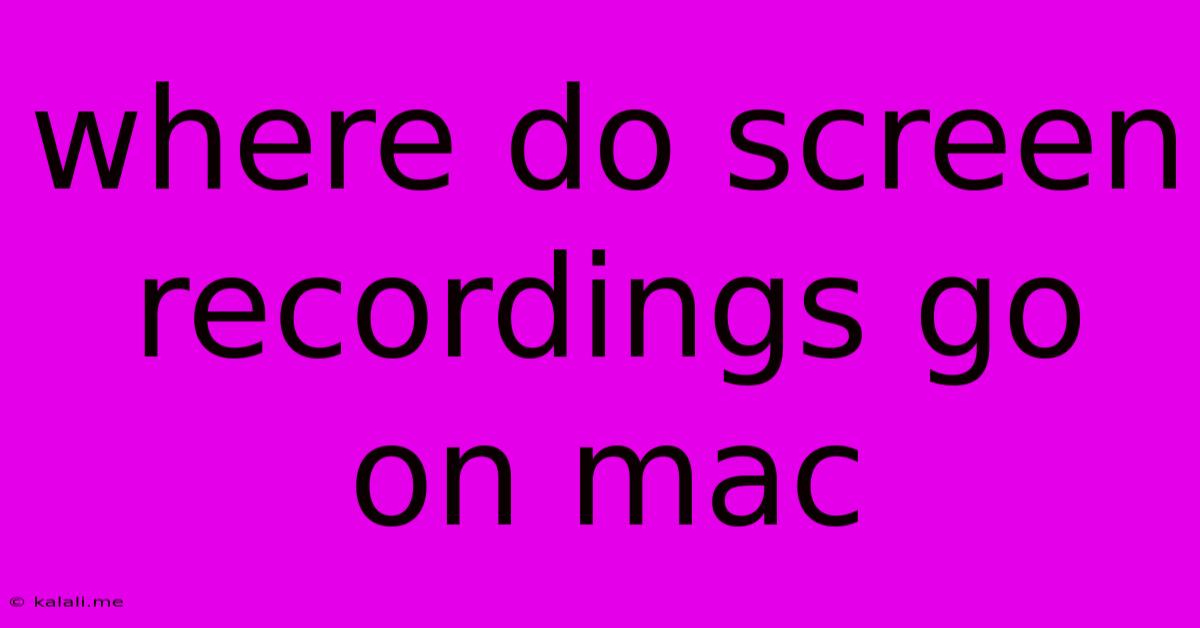Where Do Screen Recordings Go On Mac
Kalali
Jun 04, 2025 · 3 min read

Table of Contents
Where Do Screen Recordings Go on Mac? A Comprehensive Guide
Finding your precious screen recordings on your Mac can sometimes feel like a digital scavenger hunt. Luckily, it's not as complicated as it might seem. The location of your screen recordings depends primarily on the method you used to capture them. This guide will break down the most common scenarios and help you locate your files quickly and easily. This will cover QuickTime Player, third-party apps, and troubleshooting tips for when you can't seem to find your recordings.
Understanding Default Save Locations
MacOS doesn't have a single, universal location for all screen recordings. The save location is determined by the application you use. This means that recordings made with QuickTime Player will be in a different place than recordings made with OBS Studio or other screen recording software.
1. QuickTime Player Screen Recordings:
QuickTime Player is a built-in Mac application capable of creating screen recordings. By default, QuickTime Player saves screen recordings to your Movies folder. You can find this folder by following these steps:
- Finder > Go > Movies
This is the most common location, and you should always check here first. If you haven't changed the default save location within QuickTime Player's settings, your recordings will reside in this folder.
2. Third-Party Screen Recording Software:
Many popular third-party screen recording applications offer more advanced features than QuickTime Player. However, their default save locations vary significantly. Some popular choices include:
-
OBS Studio: OBS allows you to customize the output directory during setup. Check your OBS settings to locate the designated folder. Common locations are often a user-specified folder or a Documents folder within your user directory. Look for a "Recordings" or similar subfolder within this directory.
-
Screenflow: Screenflow offers flexibility in choosing output locations. Refer to your Screenflow preferences for the specific location chosen for your recordings.
-
Kap: Kap generally saves recordings to your downloads folder by default. Check your Downloads folder if you used Kap for recording.
-
Other Apps: If you're using any other third-party screen recording software, consult the application's documentation or settings to find out where it stores recordings. Usually, there is a settings section related to file paths or export preferences.
3. Troubleshooting: I Can't Find My Screen Recording!
If you've checked the obvious locations and still can't find your recordings, try these troubleshooting steps:
-
Check Recent Files: Many applications list recently accessed files in their menus (e.g., File > Open Recent).
-
Use Spotlight Search: Spotlight Search (Command + Space) is a powerful tool. Type the filename or a descriptive term related to your recording (e.g., "screen recording," "presentation," or a partial name) to find your files.
-
Review Application Preferences: Double check the settings within the screen recording software you used. Look for options related to output or save location, potentially a custom path which may be different from your default download or document location.
-
Empty Trash: Make sure you haven't accidentally deleted the recording and it's lingering in the trash.
-
Check External Drives: If you have external drives connected, ensure you haven't accidentally saved the recording onto one of those.
Optimizing Your Workflow:
To avoid this "where's my recording" dilemma in the future, consider these best practices:
-
Always Note the Save Location: Before you start recording, take a moment to note or remember where you've configured your application to save files.
-
Use Consistent Save Locations: Choose a specific folder and consistently use it for all your screen recordings. This is critical for organization.
-
Name Your Recordings Appropriately: Giving recordings descriptive names (e.g., "Project X Demo," instead of "Screen Recording 1") makes them much easier to find.
By following these tips and steps, you'll be able to locate your Mac screen recordings quickly and efficiently, freeing up your time for more important tasks. Remember, the key is understanding the specific software you’re using and its default or customized saving settings.
Latest Posts
Latest Posts
-
Connect Sposervice No Valid Oauth 2 0 Authentication Session Exists
Jun 06, 2025
-
Is There Work Done By The Lorentz Force
Jun 06, 2025
-
Standard Height Closet Shelf And Rod
Jun 06, 2025
-
What Insulation Do I Use In Showers
Jun 06, 2025
-
What Blood Type Does Jesus Have
Jun 06, 2025
Related Post
Thank you for visiting our website which covers about Where Do Screen Recordings Go On Mac . We hope the information provided has been useful to you. Feel free to contact us if you have any questions or need further assistance. See you next time and don't miss to bookmark.